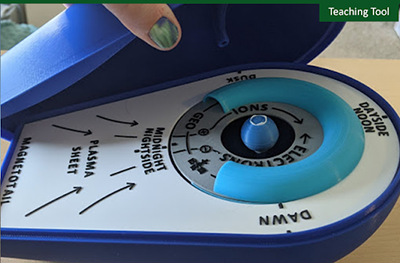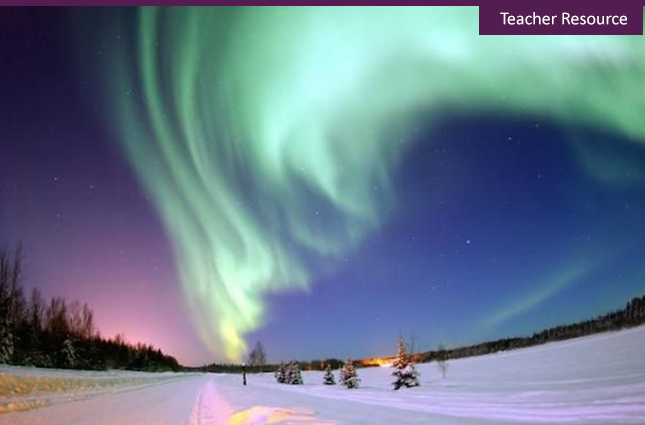
Still from “Aurora Chase!” Virtual Field Trip.
Take your class to Alberta, Canada for a virtual aurora chase! Check data to decide whether the Northern Lights are likely to appear, find a prime location, and learn about the science behind these natural wonders.
Students will be better able to explain the most basic chemistry and physics concepts behind the Northern Lights. They will gain a taste of the process of doing science, as well as the real-life applications of math and science concepts as they relate to becoming an aurora chasing citizen scientist.
Every aurora is different. New aurora chase virtual field trips coming soon! Ages 11 and up.

A woman watches an auroral display reflected in water. Photo by Christy Turner Photography.
While playing a collaborative game, students identify factors that help or hinder aurora chasers in seeing the Northern or Southern Lights. Free printable files include instructions, cards, and a reflection worksheet. Watch this space for future editions and/or expansions.
Students will be better able to answer the surprisingly complex question, “how can I see the aurora” with reference to scientific, geographic, meteorological, and other factors. Ages 11 and up.

3D Printed Magnetosphere Model, open to show interior details. Photo by Laura Brandt.
3D Printed Magnetosphere Model:
The regions of the Earth’s magnetic field, or magnetosphere, are invisible and can be challenging for students to abstract. You can build a 3D printed classroom tactile to help students visualize the areas of the magnetosphere, which are important to understanding the basic physics of the aurora and how the Sun relates to the Earth. Free files and step by step intermediate-level instructions help you or your local print lab create your own! Ages 11 and up.

Artist illustration of material from the Sun headed toward the Earth’s magnetosphere. Created by NASA.
A Newbie’s Guide to Aurora Terms:
Check out this scaffolded resource on the basic physics and vocabulary of aurora science. “When can I see the aurora” is a surprisingly complex question to answer, and this resource walks you step by step through the science of why.

Discrete aurora, photo by Senior Airman Joshua Strong, courtesy of United States Air Force, CC-NC-SA.
What causes auroras? Where and when do they occur? What causes their colors? What shapes can they be? Why are they important? How can someone photograph them? This guide gives brief answers to aurora science questions at a beginner level.

Chenille stem model of Earth’s magnetic field, designed by Dr. Alexa Halford.
More in-depth, beginner-intermediate explorations of aurora science. The Aurorasaurus blog contains resources for the general public, students, and teachers. These include a Q&A with fourth graders, a list of family-friendly resources, stories from aurora chasers, STEVE at the science fair, space weather snacks, and students building satellites!
In-depth, beginner-intermediate adult explanations, presentations, and resources on aurora science. Students can explore from home, learn about the cultural and scientific aspects of aurora, find out more about citizen and community science, and meet quirky subauroral phenomenon STEVE. Undergraduate students can take a deep dive into real scientific papers, with each paragraph explained by a NASA scientist.

Citizen scientists and Aurorasaurus Ambassadors Vincent Ledvina and Andy Witteman chasing aurora in Alaska. Photo by Vincent Ledvina.
Partnership Opportunities
Citizen science is beginning to be incorporated into many classrooms. Connecting directly with non-specialists provides authentic, hands-on opportunities to share NASA science with learners. One college professor recently told us her students never complain when they do citizen science!
Using aurora-related tweets and reports, Aurorasaurus generates a real-time, global map of the Northern and Southern Lights. Each verified tweet and report serves as a valuable data point for scientists to analyze and incorporate into space weather models. The project has made a number of discoveries. For example, Aurorasaurus, in collaboration with citizen scientists and the scientific community, published the first scientific study of STEVE (Strong Thermal Emission Velocity Enhancement), an aurora-like phenomenon that appears closer to the equator and flows from east to west. The quirkiness of STEVE has fascinated students since its publication in 2018, and provided an additional entrance to exploring not only the fascinating physics and chemistry of aurora, but the process of science itself.
Aurorasaurus is interested in partnering with educators and classrooms to co-develop resources. These partnerships may include but are not limited to:
- Piloting educational products: co-create teaching tools with us geared toward classrooms and informal learning environments
- Citizen science: High school and undergraduate students contribute to real science by examining aurora data.
- Got an idea? Let us know! As the Sun becomes more active over the coming years and the US is treated to solar eclipses, there will be many opportunities for collaboration. We are open to ideas! Get in touch at aurorasaurus.info (at) gmail.com.
Aurorasaurus is a research project that is a public-private partnership with the New Mexico Consortium supported by the National Science Foundation and NASA.
